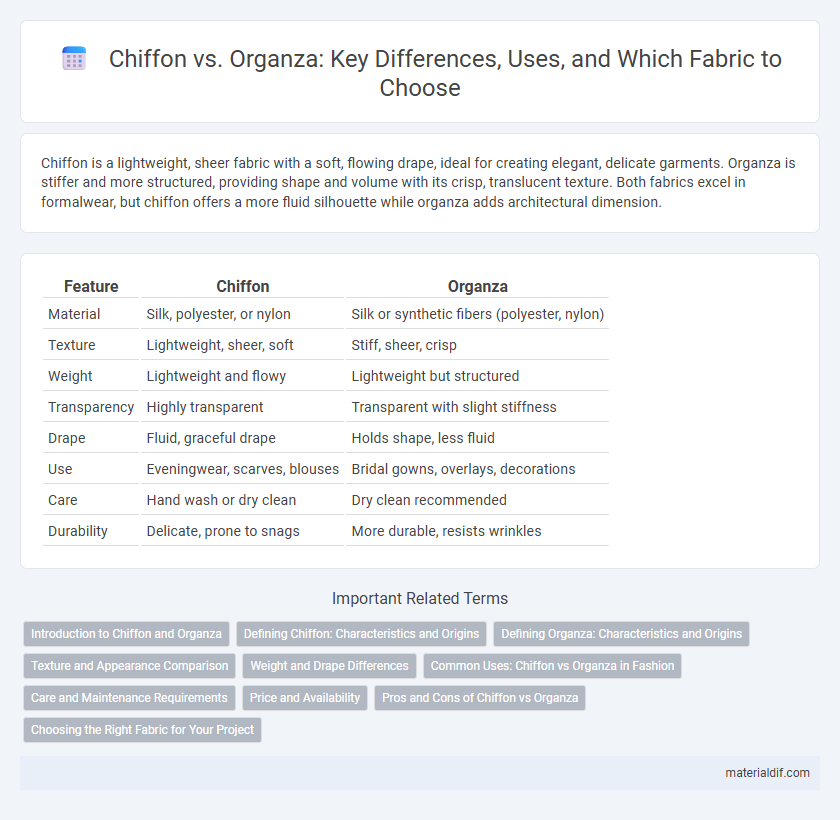Chiffon is a lightweight, sheer fabric with a soft, flowing drape, ideal for creating elegant, delicate garments. Organza is stiffer and more structured, providing shape and volume with its crisp, translucent texture. Both fabrics excel in formalwear, but chiffon offers a more fluid silhouette while organza adds architectural dimension.
Table of Comparison
| Feature | Chiffon | Organza |
|---|---|---|
| Material | Silk, polyester, or nylon | Silk or synthetic fibers (polyester, nylon) |
| Texture | Lightweight, sheer, soft | Stiff, sheer, crisp |
| Weight | Lightweight and flowy | Lightweight but structured |
| Transparency | Highly transparent | Transparent with slight stiffness |
| Drape | Fluid, graceful drape | Holds shape, less fluid |
| Use | Eveningwear, scarves, blouses | Bridal gowns, overlays, decorations |
| Care | Hand wash or dry clean | Dry clean recommended |
| Durability | Delicate, prone to snags | More durable, resists wrinkles |
Introduction to Chiffon and Organza
Chiffon is a lightweight, sheer fabric characterized by its soft drape and slightly rough texture, commonly made from silk, nylon, or polyester fibers. Organza is a crisp, translucent fabric made primarily from silk or synthetic fibers, known for its stiffness and smooth finish, often used to add volume and structure. Both fabrics are popular choices in formalwear and bridal designs, offering distinct textural qualities that influence fabric selection based on desired garment silhouette and feel.
Defining Chiffon: Characteristics and Origins
Chiffon is a lightweight, sheer fabric made from silk, nylon, or polyester fibers, known for its soft, flowing texture and slightly rough feel due to its balanced plain weave. Originating from the French word meaning "rag" or "cloth," chiffon has roots tracing back to the early 18th century and gained popularity in high fashion for its elegant drape and delicate appearance. Its fine, transparent mesh structure makes it ideal for evening wear, scarves, and overlays, distinguishing it from the stiffer, more structured organza.
Defining Organza: Characteristics and Origins
Organza is a lightweight, sheer fabric known for its crisp texture and subtle sheen, primarily made from silk or synthetic fibers like polyester. Originating from the regions of Iran and later popularized in Europe during the 18th century, organza is commonly used in evening wear, bridal gowns, and decorative overlays. Its stiffness and translucency distinguish it from chiffon, making organza ideal for structured designs requiring volume without heavy weight.
Texture and Appearance Comparison
Chiffon features a lightweight, sheer texture with a soft drape that creates an elegant, flowing appearance, while organza offers a crisp, stiff texture providing a structured and voluminous silhouette. The translucent quality of chiffon adds a delicate, ethereal look, contrasting with organza's shiny, smooth surface that reflects light for a more glamorous effect. These distinct textures and finishes make chiffon ideal for fluid garments, whereas organza suits designs requiring shape and architectural detail.
Weight and Drape Differences
Chiffon is lightweight with a soft, fluid drape, making it ideal for flowing garments and delicate overlays. Organza is stiffer and heavier, providing a structured silhouette with more volume and body. The weight difference influences the drape, where chiffon falls gently while organza maintains its shape.
Common Uses: Chiffon vs Organza in Fashion
Chiffon is commonly used in evening gowns, blouses, and scarves due to its lightweight, sheer, and flowy texture that enhances draping and movement. Organza is favored for structured garments such as bridal wear, cocktail dresses, and decorative overlays because of its stiff, crisp quality that adds volume and shape. Fashion designers often choose chiffon for softness and elegance, while organza is selected for a more architectural silhouette and formal detail.
Care and Maintenance Requirements
Chiffon requires gentle hand washing or dry cleaning to maintain its delicate, sheer texture and prevent fraying, while organza demands careful handling due to its stiffer, more structured fibers that can wrinkle easily and are often dry cleaned for optimal preservation. Both fabrics benefit from low-heat ironing with a protective cloth to avoid damage, and storing them away from direct sunlight helps prevent discoloration and fiber weakening. Proper care extends the lifespan of chiffon and organza, ensuring their lightweight, elegant appearance remains intact.
Price and Availability
Chiffon is generally more affordable and widely available than organza, making it a popular choice for budget-friendly fashion and decor projects. Organza, known for its stiffer texture and delicate sheen, tends to be pricier due to its specialized weaving process and the use of silk or high-quality synthetic fibers. Availability of organza is often limited to specialty fabric stores and luxury markets, while chiffon can be found in a broad range of retail outlets.
Pros and Cons of Chiffon vs Organza
Chiffon offers lightweight, breathable texture with excellent drape, making it ideal for flowy dresses and delicate overlays, but it tends to wrinkle easily and can be less durable. Organza provides a crisp, structured finish with a subtle sheen, perfect for voluminous gowns and bridal wear, though it is stiffer and less comfortable against the skin. Both fabrics are sheer and elegant but differ in weight and rigidity, influencing their suitability for various garment styles.
Choosing the Right Fabric for Your Project
Chiffon offers a lightweight, sheer texture with excellent draping qualities, making it ideal for flowing gowns, scarves, and delicate overlays. Organza provides a stiffer, more structured feel that holds shape well, perfect for formalwear, bridal dresses, and decorative accents. Selecting between chiffon and organza depends on whether your project requires fluid elegance or defined volume and form.
chiffon vs organza Infographic

 materialdif.com
materialdif.com